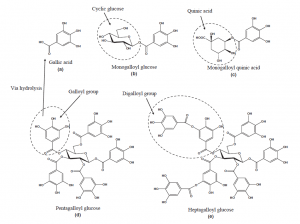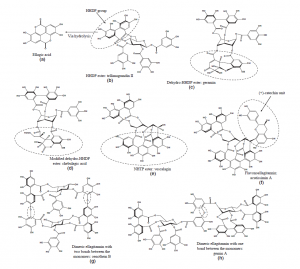The hydrolysable tannin family perhaps is the most fascinating group of tannins, since they show both structural simplicity and complexity within both monomeric and oligomeric forms
Structurally perhaps the most complex group of tannins are the hydrolysable tannins (HTs). HTs are first divided into three subclasses such as simple gallic acid derivatives, gallotannins (GTs) and ellagitannins (ETs). Simple gallic acid derivatives contain five or less galloyl groups (Fig. 1) that are most commonly esterified to either glucose (monogalloyl and pentagalloyl glucoses in Fig. 1b, d) or quinic acid (monogalloyl quinic acid in Fig. 1c).
Gallic acid derivatives that contain six or more galloyl groups are defined as GTs and are further characterized by having one or more digalloyl groups (heptagalloyl glucose in Fig. 1e).
Gallic acid derivatives and GTs are much rarer in plants than are ETs. The diverse ETs structures described to date (>500) may be divided into six subgroups: hexahydroxydiphenoyl (HHDP) esters (Fig. 2b), dehydro-HHDP esters (Fig. 2c) and their modifications (Fig. 2d), nonahydroxytriphenoyl (NHTP) esters (Fig. 2e), flavonoellagitannins (Fig. 2f), and oligomers with both varying degree of oligomerization and types of bonds between the monomers (Fig. 2g-h).


